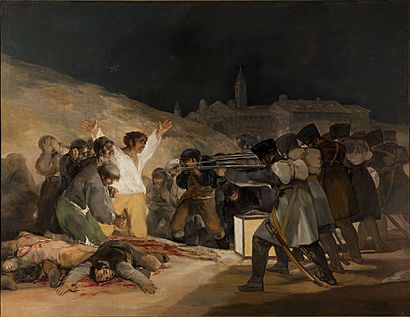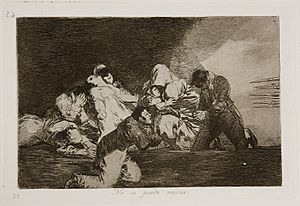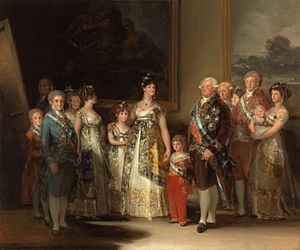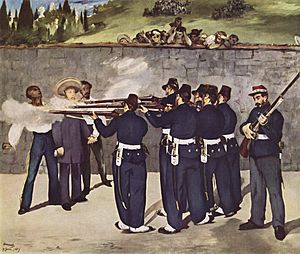The Third of May 1808 facts for kids
Quick facts for kids The Third of May 1808 |
|
|---|---|
 |
|
| Artist | Francisco Goya |
| Year | 1814 |
| Medium | Oil on canvas |
| Dimensions | 268 cm × 347 cm (106 in × 137 in) |
| Location | Museo del Prado, Madrid |
The Third of May 1808 is a famous painting finished in 1814 by the Spanish artist Francisco Goya. It is now kept in the Museo del Prado museum in Madrid, Spain. In this artwork, Goya wanted to show how the Spanish people bravely fought back against Napoleon's armies. This happened when France occupied Spain in 1808 during the Peninsular War.
The painting is very powerful and shows the terrible side of war. It was different from other war paintings of its time. Many experts believe The Third of May 1808 was one of the first truly modern paintings. It broke away from old art rules. Art historian Kenneth Clark called it "the first great picture which can be called revolutionary in every sense of the word."
This important painting has inspired many other artists and artworks. For example, it influenced the famous peace sign designed by Gerald Holtom. It also inspired paintings by Édouard Manet and Pablo Picasso's well-known works like Massacre in Korea and Guernica.
Contents
Why Goya Painted This: The Story Behind It

In 1804, Napoleon I of France became Emperor of France. Spain was very important to France because it controlled access to the Mediterranean Sea. The king of Spain at the time, Charles IV, was not a strong ruler. Napoleon took advantage of this. He tricked Spain into letting French troops enter the country.
By February 1808, it became clear that Napoleon wanted to take over Spain. His brother, Joseph Bonaparte, was even planned to become the new king. The Spanish people did not like this new French rule. They felt insulted and angry.
On May 2, 1808, the people of Madrid rebelled. They were upset because the last members of the Spanish royal family were being sent to France. Goya painted another work, The Second of May 1808, to show this uprising. It shows a fight between Spanish rebels and French soldiers in Madrid's main square.
The Third of May 1808 shows what happened next. The French soldiers took revenge. Before dawn on May 3, hundreds of Spanish people were gathered up and shot in different places around Madrid. This event was a big part of the five-year Peninsular War, which was one of the first "guerrilla wars" (meaning small groups fighting against a larger army).
Goya, like many Spanish thinkers, was in a difficult spot during the French invasion. He had liked the ideas of the French Revolution at first. But he also saw his own people being treated badly by the French. He painted very little during these years. However, his experiences inspired a series of drawings called The Disasters of War.
In February 1814, after the French were finally pushed out of Spain, Goya asked the government if he could paint important events from the uprising. His idea was accepted, and he began working on The Third of May. It's not known if Goya actually saw the rebellion or the executions himself.
What the Painting Shows
A Closer Look at the Scene
The Third of May 1808 takes place in the early morning after the uprising. The painting focuses on two groups of men. On the right, there is a group of French soldiers, standing in a straight line, ready to shoot. On the left, there is a messy group of Spanish captives, held at gunpoint. The soldiers and victims face each other very closely.
A bright square lantern on the ground lights up the scene. The brightest light falls on the Spanish victims on the left. Among them is a monk or priest praying. Next to them, other people are waiting to be shot. The main figure is a man kneeling in the middle of the painting. He is brightly lit, and his arms are thrown wide open, either asking for mercy or showing defiance. His yellow and white clothes match the colors of the lantern. His simple white shirt and tanned face show he is an ordinary worker.
The firing squad on the right is mostly in shadow. They look like a solid, dark block. Their bayonets (knives on their guns) and their tall hats (shakos) form a strong, unmoving line. You can't see most of their faces, which makes them seem less human. In the background, you can see a town with a church steeple in the dark night. There's also a crowd with torches in the distance, perhaps more soldiers or people watching.
Goya's Disasters of War Prints

Goya also created a series of prints called The Disasters of War. He made most of these prints between 1810 and 1814. These prints show the terrible things he saw and felt during the war. Some of these prints have similar scenes to The Third of May. For example, one print called One cannot look at this shows people with their arms outstretched, similar to the main figure in the painting. Another print, And it cannot be helped, also shows a firing squad. These prints show how Goya used his art to express the horrors of war.
The Painting's Special Meaning
When it was first shown, some art critics had mixed feelings about The Third of May. Artists usually painted war in a grand, heroic way. But Goya showed the brutal, unheroic side of war, which was unusual for his time. Some thought the painting had technical flaws, like the perspective not being perfect. However, many believe Goya did this on purpose to make the painting more powerful.
The Third of May connects to older Christian art that showed people being martyred (dying for their beliefs). The dramatic use of light and shadow (called chiaroscuro) and the contrast between life and death are similar. The man with raised arms is often compared to Jesus on the cross. He even has marks on his right hand that look like stigmata (wounds like Christ's). The lantern in the middle is like the light used by the Roman soldiers who arrested Jesus.
However, Goya's painting is different. In older art, light often represented God's presence. But in The Third of May, the lantern only lights up the scene so the soldiers can do their terrible work. It simply shows the violence clearly. Goya doesn't try to make the scene beautiful or artistic. The colors are dark, with flashes of white and red. The painting's power comes from its raw, horrifying force.
Where the Painting Has Been

Even though the painting was important, we don't know much about its first public showing. It wasn't mentioned in many records from that time. This might be because the new king, Ferdinand VII, preferred older, more traditional art. He also didn't like paintings that showed popular rebellions.
Some stories say the painting was stored away for 30 to 40 years before people saw it. It was listed in a Prado museum inventory in 1834, meaning it stayed with the government or royal family. The famous French writer Théophile Gautier mentioned seeing a "massacre" by Goya at the museum in 1845.
Both The Third of May and The Second of May paintings were damaged during the Spanish Civil War. They were being moved by truck to Valencia for safety. This was probably the only time they left Madrid. The damage was left unrepaired for a long time. In 2008, both paintings were restored for an exhibition celebrating 200 years since the uprising.
In 2009, the Prado museum chose The Third of May 1808 as one of its 14 most important paintings. It was put on Google Earth so people could see it in amazing detail.
How it Influenced Other Art

The Third of May has had a huge impact on other artists. One of the first artists to be inspired by it was Édouard Manet. He painted his Execution of Emperor Maximilian in the late 1860s. Manet's painting also shows an execution and borrowed ideas from Goya's work.
The Third of May also influenced Pablo Picasso's famous 1937 painting Guernica. Guernica shows the terrible aftermath of a bombing during the Spanish Civil War. In 2006, the Prado museum even displayed The Third of May, Guernica, and Manet's Execution of the Emperor Maximilian in the same room. Picasso's 1951 painting Massacre in Korea, which shows a scene from the Korean War, is an even more direct copy of Goya's composition.
Many art experts have praised Goya's painting. Aldous Huxley said in 1957 that Goya spoke "in his native language" in this painting, making it very powerful and clear. Kenneth Clark noted how different it was from traditional history paintings. He said, "With Goya we do not think of the studio or even of the artist at work. We think only of the event." This shows how real and impactful the painting feels.
Images for kids
-
Giovanni Battista Tiepolo's 1722 St. Bartholomew, a traditional scene of martyrdom.
See also
 In Spanish: El 3 de mayo en Madrid para niños
In Spanish: El 3 de mayo en Madrid para niños




